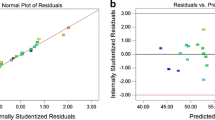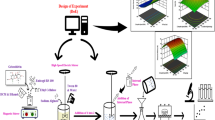Abstract
The objective of this study was to determine optimum extrusion–spheronisation parameters for producing bioactive-loaded beads with maximum consistency. The Taguchi method for robust engineering design was applied, using an L9 orthogonal array (fractional factorial design). The processing parameters analysed were spheronising speed, time and the amount of granulating liquid. The potential importance of some interactive effects was assessed by applying a response surface analysis to the data. The amount of granulating liquid, spheronising speed and the interaction between these two parameters were found to have a statistically significant influence on the size, with the amount of granulating liquid being the most dominant factor. The diameter of beads increased with the amount of granulating liquid and consequently, reduced the yield in the desired range (600–1,180 µm). The roundness of the beads was strongly influenced by the spheronising time. The beads became rounder with increasing spheronising time, up to a limit when the effect was observed to level off. Similar optimum conditions were indicated by a response surface method and the Taguchi method: low amount of granulating liquid (50%, w/w) and extrudates spheronised at the highest speed (1,800 rpm) for 15 min. However, the predicted response values using the Taguchi method were physically more acceptable: yield in the desired size range of 98.83%, D50 of 662 µm and roundness of 0.82.








Similar content being viewed by others
References
Agrawal, A. M., Howard, M. A., & Neau, S. H. (2004). Extruded and spheronized beads containing no microcrystalline cellulose: Influence of formulation and process variables. Pharmaceutical Development and Technology, 9, 197–217.
Anderson-Cook, C. M., Borror, C. M., & Montgomery, D. C. (2009). Response surface design evaluation and comparison. Journal of Statatistical Planning and Inference Inference, 139, 629–641.
Baert, L., Vermeersch, H., Remon, J. P., Smeyers-Verbeke, J., & Massart, D. L. (1993). Study of parameters important in the spheronization process. International Journal of Pharmaceutics, 96, 225–229.
Chan, L. W., Tang, E. S. K., & Heng, P. W. S. (2006). Comparative study of the fluid dynamics of bottom spray fluid bed coaters. AAPS PharmSciTech, 7, E37.
Colla, E., Pereira, A. B., Hernalsteens, S., Maugeri, F., and Rodrigues, M. I. (2009) Optimization of trehalose production by Rhodotorula dairenensis following a sequential strategy of experimental design. Food and Bioprocessing Technology, in press. doi: 10.1007/s11947-008-0081-y
Gandhi, R., Kaul, C. K., & Panchagnula, R. (1999). Extrusion and spheronization in the development of oral controlled-release dosage forms. Pharmaceutical Science & Technology Today, 2, 160–170.
Hasznos, L., Langer, I., & Gyarmathy, M. (1992). Some factors influencing pellets characteristics made by an extrusion/spheronization process Part I.: Effects on size characteristics and moisture content decrease of pellets. Drug Development and Industrial Pharmarmacy, 18, 409–437.
Hellen, L., Yliruusi, J., & Kristoffersson, E. (1993). Process variables of instant granulator and spheroniser: II. Size and size distributions of pellets. International Journal of Pharmaceutics, 96, 205–216.
Heng, P. W. S., & Koo, O. M. Y. (2001). A study of the effects of the physical characteristics of microcrystalline cellulose on performance extrusion spheronization. Pharmaceutical Research, 18, 480–487.
Kanbe, H., Hayashi, T., Onuki, Y., & Sonobe, T. (2007). Manufacture of fine sphericals granules by an extrusion/spheronization method. International Journal of Pharmaceutics, 337, 56–62.
Kaur, S., Sarkar, B. C., Sharma, H. K., & Singh, C. (2009). Optimization of enzymatic hydrolysis pretreatment conditions for enhanced juice recovery from guava fruit using response surface methodology. Food and Bioprocessing Technology, 2, 96–100.
Ko, S. P., Tan, C. P., Lai, O. M., Arifin, N., Yusoff, M. S. A., and Long, K. (2009). Enzymatic synthesis of medium and long chain triacylglycerols (MLCT): optimization of process parameters using response surface methodology. Food and Bioprocessing Technology, in press. doi:10.1007/s11947-008-0073-y
Krogars, K., Heinämäki, J., Vesalahti, J., Marvola, M., Antikainen, O., & Yliruusi, J. (2000). Extrusion–spheronization of pH-sensitive polymeric matrix pellets for possible colonic drug devivery. International Journal of Pharmaceutics, 199, 187–194.
Ku, C. C., Joshi, M. Y., Bergum, S. J., & Jain, B. N. (1993). Bead manufacture by extrusion/spheronization—a statistical design for process optimization. Drug Development and Industrial Pharmacy, 19, 1505–1519.
Liew, C. V., Chua, S. M., & Heng, P. W. S. (2007). Elucidation of spheroid formation with and without the extrusion step. AAPS PharmSciTech, 8(10), E1–E12.
Mamatha, S. S., Ravi, R., & Vankateswaran, G. (2008). Medium optimization of gamma linoleic acid production in Mucor rouxii CFR-G15 using RSM. Food and Bioprocessing Technology, 1, 405–409.
Maronga, S. (1998). On the optimization of the fluidized bed particulate coating process. PhD Thesis. Royal Institute of Technology, Stockholm, Sweden.
Montgomery, D. (2009). Design and analysis of experiments (7th ed.). Hoboken NJ (USA): J. Wiley & Sons.
Newton, J. M., Chapman, S. R., & Rowe, R. C. (1995). The influence of process variables on the preparation and properties of spherical granules by the process of extrusion and spheronization. International Journal of Pharmaceutics, 120, 101–109.
Oztopa, M. H., Sahin, S., & Sumnu, G. (2007). Optimization of microwave frying of potato slices by using Taguchi technique. Journal of Food Engineering, 79(1), 83–91.
Ramaswamy, H. S., and Dwivedi, M. (2009). Effect of process variables on heat transfer rates to canned particulate Newtonian fluids during free bi-axial rotary processing. Food and Bioprocessing Technology, in press. doi:10.1007/s11947-008-0140-4
Ross, P. J. (1988). Taguchi techniques for quality engineering. New York (USA): McGraw-Hill.
Sguarezi, C., Longo, C., Ceni, G., Boni, G., Silva, M. F., Luccio, M., et al. (2009). Inulase production by agro-industrial residues: optimization of pretreatment of substrates and production medium. Food and Bioprocessing Technology, in press. doi:10.1007/s11947-008-0081-x
Shankar, T. J., Sokhansanj, S., Bandyopadhyay, S., and Bawa, A. (2009). A case study of optimization of biomass flow during single screw extrusion cooking using genetic algorithm (GA) and response surface methodology (RSM). Food and Bioprocessing Technology, in press. doi:10.1007/s11947-008-0172-9
Sinha, V. R., Agrawal, M. K., & Kumria, R. (2005). Influence of formulation and excipient variables on the pellet properties prepared by extrusion spheronization. Current Drug Delivery, 2, 1–8.
Sinha, V. R., Agrawal, M. K., Kumria, R., & Bhinge, J. R. (2007). Influence of operational variables on properties of piroxicam pellets prepared by extrusion-spheronization: A technical note. AAPS PharmSciTech, 8(1), E1–E5. Article 20.
Sonaglio, D., Bataille, B., Ortigosa, C., & Jacob, M. (1995). Factorial design in the feasibility of producing Microcel MC 101 pellets by extrusion/spheronization. International Journal of Pharmaceutics, 115, 53–60.
Sousa, J. J., Sousa, A., Podczeck, F., & Newton, J. M. (2002). Factors influencing the physical characteristics of pellets obtained by extrusion-spheronization. International Journal of Pharmaceutics, 232, 91–106.
Sparks, R. E., Jacods, I. C., & Mason, N. S. (1999). Microencapsulation. In Avis, Shukla, & Chang (Eds.), Pharmaceutical unit operations: Coating (pp. 177–222). Florida, USA: CRC Press LLC.
Sriamornsak, P., Burton, M.A. and Kennedy, R.A. (2006). Development of polysaccharide gel coated pellets for oral administration. 1. Physico-mechanical properties. International Journal of Pharmaceutics, 326 (1-2), 80-88
Sudsakorn, K., & Turton, R. (2000). Nonuniformity of particle coating on a size distribution of particles in a fluidized bed coater. Powder Technology, 110, 37–43.
Taguchi, G., Chowdury, S., & Taguchi, S. (2000). Robust engineering. New York (USA): McGraw-Hill.
Vardenega, R., Remonatto, D., Arbter, F., Polloni, A., Rigo, E., Ninow, J., et al. (2009). A systematic study on extraction of lipase obtained by solid state fermentation of soybean meal by a newly isolated strain of Penicillium sp. Food and Bioprocessing Technology, in press. doi:10.1007/s11947-009-0224-9
Vervaet, C., Baert, L., & Remon, J. P. (1995). Extrusion-spheronization A literature review. International Journal of Pharmaceutics, 116, 31–146.
Wan, S. C., Heng, P. S. W. S., & Liew, C. V. (1993). Spheronization conditions on spheroid shape and size. International Journal of Pharmaceutics, 96, 59–65.
Acknowledgement
This work was supported by the Food Institutional Research Measure of the Department of Agriculture and Food, Ireland, under the National Development Plan 2000–2006. The authors would like to thank FMC Biopolymer, Ireland for providing Avicel PH 101®.
Author information
Authors and Affiliations
Corresponding author
Rights and permissions
About this article
Cite this article
Kuang, S.S., Oliveira, J.C. & Crean, A.M. An Analysis of the Influence of Multiple Processing Factors on the Characteristics of Bioactive-Loaded Beads Prepared by Extrusion–Spheronisation. Food Bioprocess Technol 5, 55–64 (2012). https://doi.org/10.1007/s11947-009-0308-6
Received:
Accepted:
Published:
Issue Date:
DOI: https://doi.org/10.1007/s11947-009-0308-6




